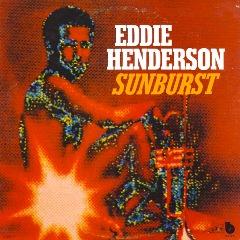Eddie Henderson - Sunburst (1975)
Eddie Henderson - Sunburst (1975)

1 Explodition 6:38 2 The Kumquat Kids 4:29 3 Sunburst 5:46 4 Involuntary Bliss 6:50 5 Hop Skotch 3:52 6 Galaxy 6:34 7 We End In A Dream 3:10 Eddie Henderson - Trumpet, Flugelhorn, Cornet Bennie Maupin - Saxophone [Saxello], Saxophone [Tenor], Clarinet [Bass] Julian Priester - Trombone, Horn [Post Horn] George Duke - Piano [Electric], Clavinet, Synthesizer Alphonso Johnson - Bass [Electric], Effects (1 – 6) Buster Williams – Bass (7) Harvey Mason – Drums (1 – 6) Billy Hart – Drums (7) Bobby Hutcherson – Marimba (6)
Well, I’m still not aware if Henderson had a musical professional background (he was a professional figure ice-skater and medical student, though) before being part of Herbie’s Mwandishi group (I’d imagine Hancock not hiring rookies), but since the dismantling of that magic group, its three hornmen (Maupin, Priester and Eddie) made some brilliant solo JR/F albums, this being Henderson’s second of third effort. Eddie’s first two solo effort (Realization and Inside Out) bore many Swahili-tribe skin-scars, but Sunburst kinds of disengage somewhat from that realm. Don’t get me wrong though, there are still some heavy Mwandishi friends on Sunburst as both Priester and Maupin are present, but so are Williams and Hart (for only one track, though), but check out George Duke, Hutcherson, Harvey and Alphonso’s presence as well. What a friggin’ line-up.
Despite being released on the then-fledging Blue Note album, Sunburst sports a convincing and appropriate red-hot modern artwork that describes the volcanic musical fusion. The ultra-funky opener of Explodition features a funky Alphonso bass line with Henderson’s trumpet soaring high over sun-burned soundscapes made from Duke’s Rhodes and synth, and un-credited funky guitar lines (low in the mix). The following Kumquat track could find a spot on Hancock’s Head Hunter album and it features a bit (way too few, IMHO) of Maupin’s delightful bass clarinet, while Henderson is trump(et)ing Miles’ effect-laden horn. The steaming title track might just be my fave of the album. It is a little unfortunate that the album’s lengthiest track takes a little to long to unravel its fierce nature after a tamer intro, but Duke’s keyboard works in the calmer (at first) middle section partially makes up for it. The short ultra-funky Hop scotch is the album’s weakest track, even if the musicians do strut their chops. The spacey Galaxy piece is quite a change from its preceding sister, and after a cosmic intro, Maupin’s bass clarinet is finally unleashed and running amok in the Universe’s naught. Amazing stuff!! The closing aptly-titled We End In A Dream sports a slightly different line-up and hints more at Crossing the Sextant.
Sunburst is IMHO Henderson’s last really-worthy album, as later-70’s works will shift even further out with RnB and funk, thus being increasingly mainstream, which is never good news, neither to a fan’s ears or the artiste’s wallet, because such efforts may bring a tad more revenues, but generally ruins the author’s credibility. Nevertheless, Henderson’s legacy is that he managed an outstanding trilogy of album, of which this s the last chapter. ---Sean Trane, jazzmusicarchives.com
Switching over to Blue Note, which was then reaping a fortune with Donald Byrd's R&B outfit, Eddie Henderson pursued a harder, earthier, more structured, funk-driven sound on his first album, while maintaining some of his marvelously spacier instincts for spice. Henderson continued to keep several components of the Herbie Hancock Septet together, for drummer Billy Hart, bassist Buster Williams, reedman Bennie Maupin, and now trombonist Julian Priester are back. But this time, Hancock is replaced by George Duke, and fusionaire bassist Alphonso Johnson and drummer Harvey Mason (late of the Headhunters) are added -- and these switches make much of the difference. Duke is as much of an techie as Herbie was; he delights in flaunting his Echoplex and burbling, shooting, twinkling synthesizer effects. Henderson himself is more into electronic echo and wah-wah effects than before, definitely pursuing the current Miles Davis line but in a brighter, more tonally brilliant manner, and Maupin has many impassioned and creepy (on bass clarinet) moments. The title track, a ruminative Henderson tune with a leaping funk beat, and Mason's archetypical funk workout "Hop Scotch" are the best cuts. ---Richard S. Ginell
download (mp3 @320 kbs):
yandex 4shared mega mediafire cloudmailru uplea ge.tt








